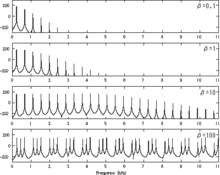FM synthesis
The FM synthesis or frequency modulation synthesis refers to a technical modulation method , which on the Frequency modulation based. In the simplest case, the first frequency is frequency-modulated directly by the amplitude of the second oscillator by means of two oscillators .
In contrast to the frequency modulation used as a transmission system in radio and communications technology, the two frequencies in FM synthesis are spectrally close to one another. The motivation is to obtain complex signal courses that cannot be obtained with individual oscillators. For applications in the field of electronic music and sound engineering, the individual basic frequencies are in the frequency range that can be heard by humans.
Math background
The frequency modulation synthesis is part of the non-linear analog synthesis technology and can easily be simulated digitally if the so-called Nyquist frequency for the partials generated is not exceeded , taking into account the sampling theorem .
The following applies:
With for the amplitude, for the carrier circle frequency, for the modulation circle frequency, for the modulation index and for the time.
Simple frequency modulation synthesis

The core of a simple FM synthesis is a pair of oscillators , the so-called operators . The frequency of the first oscillator can be controlled by the second oscillator. The first oscillator is the carrier and the second is the modulator . This principle has long been known from VHF radio transmission. With slow modulation up to 10 Hz a vibrato is created; If the carrier is modulated with a frequency in the audible range (i.e. from 20 Hz upwards), vibrato can no longer be heard; instead, further overtones are added to the fundamental tone of the carrier.
Complex frequency modulation synthesis
Complex FM synthesis is when several modulators are used that modulate a single carrier. In this case, the resulting frequency spectrum is basically composed of the individual spectra of each modulator-carrier pair.
Parallel connection of the modulators
Modulator 1 and at least one further modulator 2 are modulated and the latter is then fed to the carrier. The final signal is composed of the frequency spectrum modulator 1, modulator 2 and carrier in such a way that it corresponds to an addition of the spectra from modulator 1 + carrier and modulator 2 + carrier.
Cascade connection of the modulators
In the cascade connection, the modulator pair 1 + 2 acts like a modulator-carrier pair in series. Each partial sine tone now modulates the carrier. In principle, the result is a frequency spectrum that is very similar to the parallel connection. The only thing that matters is that the sidebands of modulator 2 are omitted in most of the connection options.
history
The theoretical foundations of frequency modulation were developed in 1922 by John Renshaw Carson , based on the ideas of Jean Baptiste Joseph Fourier , for the purposes of communications engineering. In 1967, the American John Chowning discovered at Stanford University, when two sinusoidal oscillations were modulated, the creation of spectra extremely rich in overtones. He had his discovery patented by Stanford University and published the results of his research in 1973. In 1974, the Yamaha company licensed the patent . In 1982 Yamaha presented the synthesizers GS1 and GS2, which worked with this technology for the first time, but only years after the Synclavier from New England Digital already worked with FM synthesis, which can therefore be considered the first commercially produced FM synthesizer.
The most widely applicable and therefore most popular FM synthesizer is the Yamaha DX7 introduced in 1983 , which is still offered as a virtual synthesizer by Native Instruments under the name FM8.
literature
- John M. Chowning: The Synthesis of Complex Audio Spectra by Means of Frequency Modulation. In: Journal of the Audio Engineering Society. Vol. 21, No. 7, 1973, ISSN 1549-4950 , pp. 526-534.
- Curtis Roads, John Strawn (Ed.): Foundations of Computer Music . MIT Press, Cambridge MA et al. 1985, ISBN 0-262-18114-2 .
- John M. Chowning, David Bristow: FM Theory & Applications. By Musicians for Musicians . Yamaha Music Foundation, Tokyo 1986, ISBN 4-636-17482-8 .






